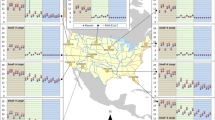Abstract
Laboratory experiments have been performed to investigate the effects of salt exclusion on the behaviour of lakes with salinities up to 8 g L−1. At these salinities the freezing temperature is less than the temperature of maximum density and, unlike sea-ice, a reverse temperature stratification forms beneath the ice that can support at least some of the excluded salt. Temperature time series at four depths showed that salt exclusion drives cascades of localised overturning, while the persistence of reverse temperature stratification indicated that mixing was not complete. While our array of temperature sensors had insufficient spatial resolution to provide full details of the flow, we hypothesize that: at salinities of 1 and 2 g L−1 salt is released relatively uniformly and forms a layer of elevated salinity immediately below the ice, which supports double-diffusive salt-fingering; and at salinities of 4 and 8 g L−1, salt plumes penetrate the reverse stratification. After the ice melted, a relatively fresh surface layer formed above a more saline layer, sufficient to suppress spring turnover. Our measurements compare favourably with field observations from lakes, and highlight the importance of salt exclusion on biogeochemical processes in lakes.




Similar content being viewed by others
References
Adams CM Jr, French DN, Kingery WD (1960) Solidification of sea ice. J Glaciol 3:745–761
Anderson DL (1961) Growth rate of sea ice. J Glaciol 3(30):1170–1172
Ashton GD (1989) Thin ice growth. Water Resour Res 25(3):564–566. doi:10.1029/WR025i003p00564
Belzile C, Gibson JAE, Vincent WF (2002) Colored dissolved organic matter and dissolved organic carbon exclusion from lake ice: implications for irradiance transmission and carbon cycling. Limnol Oceanogr 47(5):1283–1293. doi:10.4319/lo.2002.47.5.1283
Carmack E (1990) Large-scale oceanography of polar oceans. In: Smith W (ed) Polar Oceans. Academic, Cambridge, pp 171–222
Chen CT, Millero FJ (1986) Precise thermodynamic properties for natural waters covering only the limnological range. Limnol Oceanogr 31:657–662
Dugan HA, Lamoureux SF (2011) The chemical development of a hypersaline coastal basin in the High Arctic. Limnol Oceanogr 56(2):495–507. doi:10.4319/lo.2011.56.2.0495
Fisher TSR, Lawrence GA (2006) Treatment of acid rock drainage in a meromictic mine pit lake. J Environ Eng 132(4):515–526. doi:10.1061/(ASCE)0733-9372(2006)132:4(515)
Forrest AL, Laval BE, Pieters R, Lim DSS (2008) Convectively driven transport in temperate lakes. Limnol Oceanogr 53:2321–2332. doi:10.4319/lo.2008.53.5_part_2.2321
Gibson JAE (1999) The meromictic lakes and stratified marine basins of the Vestfold Hills, East Antarctica. Antarct Sci 11(2):175–192. doi:10.1017/S0954102099000243
Kirillin G, Lepparanta M, Terzhevik A, Granin N, Bernhardt J, Engelhardt C, Efremova T, Golosov S, Palshin N, Sherstyankin P, Zdorovennova G, Zdorovennov R (2012) Physics of seasonally ice-covered lakes: a review. Aquat Sci 74(4):659–682. doi:10.1007/s00027-012-0279-y
Lawrence GA, Tedford EW, Pieters R (2016) Suspended solids in an end pit lake: potential mixing mechanisms. Can J Civ Eng 43(3):211–217. doi:10.1139/cjce-2015-0381
Lide DR (ed) (2006) CRC handbook of chemistry and physics, 86th edn. CRC Press, pp 5–71, 5–73, 8–66
Mironov D, Terzhevik A, Kirillin G, Jonas T, Malm J, Farmer D (2002) Radiatively driven convection in ice-covered lakes: Observations, scaling, and a mixed layer model. J Geophys Res 107:16 pp., doi:10.1029/2001JC000892. http://www.agu.org/journals/ABS/2002/2001JC000892.shtml
Ouellet M, Pagé P (1987) Comments on “Hypersaline gradients in two Canadian High Arctic Lakes” by K. M. Stewart and R. F. Platford. Can J Fish Aquat Sci 44:1676–1680
Pagé P, Ouellet M, Hillaire-Marcel C, Dickman M (1984) Isotopic analyses \(({}^{18} \text{ O }, {}^{13} \text{ C }, {}^{14}\text{ C })\). Limnol Oceanogr 29(3):564–573. doi:10.4319/lo.1984.29.3.0564
Pawlowicz R (2008) Calculating the conductivity of natural waters. Limnol Oceanogr Methods 6:489–501
Pieters R, Lawrence GA (2009) Effect of salt exclusion from lake ice on seasonal circulation. Limnol Oceanogr 54(2):401–412. doi:10.4319/lo.2009.54.2.0401
Schmitt R (1979) Flux measurements on salt fingers at an interface. J Mar Res 37:419–436
Stewart KM, Platford RF (1986) Hypersaline gradients in two Canadian High Arctic lakes. Can J Fish Aquat Sci 43(9):1795–1803. doi:10.1139/f86-223
Washburn EW (1926–1930; 2003) International critical tables of numerical data, physics, chemistry and technology, 1st electronic edn, Knovel. Online version available at: http://app.knovel.com/hotlink/toc/id:kpICTNDPC4/international-critical/international-critical
Welch HE, Bergmann MA (1985) Water circulation in small arctic lakes in winter. Can J Fish Aquat Sci 42:506–520
Acknowledgements
The Natural Sciences and Engineering Research Council of Canada supported this research through a Postgraduate Research Scholarship to C.E. Bluteau, in addition to a Discovery Grant and Northern Research Supplement to G.A. Lawrence, who is also grateful for the support of a Canada Research Chair.
Author information
Authors and Affiliations
Corresponding author
Rights and permissions
About this article
Cite this article
Bluteau, C.E., Pieters, R. & Lawrence, G.A. The effects of salt exclusion during ice formation on circulation in lakes. Environ Fluid Mech 17, 579–590 (2017). https://doi.org/10.1007/s10652-016-9508-6
Received:
Accepted:
Published:
Issue Date:
DOI: https://doi.org/10.1007/s10652-016-9508-6




